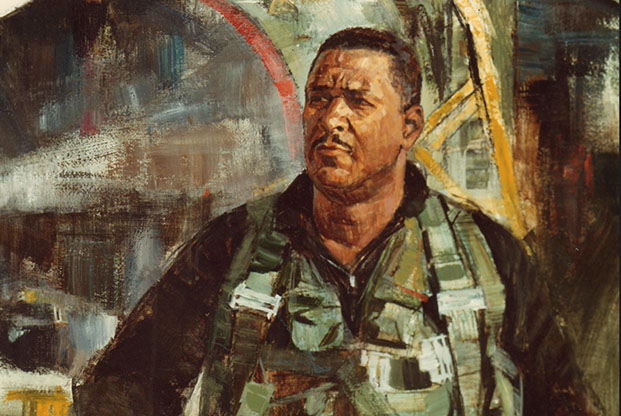
A signed portrait of Gen. Daniel “Chappie” James hangs in the Pentagon. It pictures James in front of his F-4 at Ubon AB, Thailand, during Vietnam. Painting: Maxine McCaffery/USAF
Air Force Col. Daniel “Chappie” James Jr. was not going to let Muammar Qaddafi push him around. Facing the mercurial Libyan leader across a dusty patch of desert outside US-controlled Wheelus Air Base in Libya, James told him to move his hand away from the fancy sidearm holstered on his hip.
Or else.
The threat was far from empty. As James told the story, he carried his own .45 in his belt.
Tall and imposing, James entered Tuskegee Institute on a football scholarship. A Tuskegee Airman, he’d served in World War II and flown almost 200 combat missions in Korea and Vietnam. His drive and skill would eventually help make him the first four-star African-American general in the US military and the commander of NORAD.
“I fought in three wars and three more wouldn’t be too many to defend my country,” he later scribbled on a portrait that would hang in the Pentagon.
But in early 1970, that was in the future. As commander of the 7272nd Fighter Training Wing, then-Col. James was responsible for managing the US withdrawal from Wheelus, a hot and dry installation whose value as a strategic bomber base had declined with the rise of nuclear missiles.
Qaddafi and other radical Libyan officers had seized power in a coup in late 1969, after the US had already agreed to turn the base over. Almost immediately Qaddafi began pushing to see what more he could get. James was determined to not be bullied out early, or to unnecessarily turn over vehicles and other valuable equipment.
Their face-to-face standoff became an Air Force legend. As the final days for Wheelus approached, Qaddafi ran a column of half-tracks through the base housing area at full speed. James shut the gate to prevent further passage and met Qaddafi a few yards outside the barrier. The US commander noted that the Libyan had a fancy gun in a holster strapped to his leg. As the pair talked Qaddafi moved his hand onto the grip of the weapon.
“I told him to move his hand away. If he had pulled that gun, he never would have cleared his holster,” James recalled.
The moment passed without escalation, and a short time later James successfully completed the removal of 4,000 people and $21 million in assets from a base the US had hosted warplanes at since 1943.
Superiors and associates were not surprised by James’ skillful handling of the Wheelus situation. After all, this was an officer used to pressure, who had grown up in segregation and faced prejudice and resistance as the US military fully integrated following World War II. He was a steady combat leader and fighter pilot who played a key role in Operation Bolo, the innovative 1967 operation that struck a heavy blow against the North Vietnamese Air Force.
James saw almost every aspect of the Air Force while serving during three “hot” wars (fighting in two of them), and holding key Cold War leadership positions.
Persistence in the execution of tasks was an ingrained part of his personality. It was a credo he passed along to his son, Daniel James III, who himself rose to the rank of Air Force lieutenant general and commanded the Air National Guard from 2002 to early 2006.
“In my home, the 11th Commandment was ‘I shall not quit’,?” said the younger James in a 2009 speech. “We were not allowed to give up. After you proved that you have given 110 percent, [my father] would say, ‘Good, let’s start over’.?”
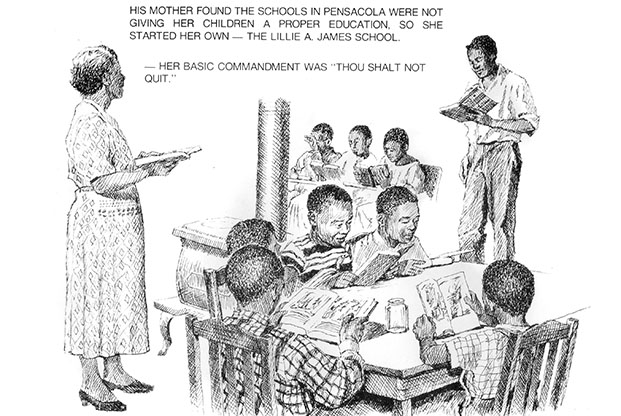
Civil Air Patrol and the National Aerospace Education Association published a series of “aerospace personality” workbooks for children. Number 4 featured James’ life. Illustration: CAP/NEA
Daniel James Jr. was born in 1920 in Pensacola, Fla., the last of his parents’ 17 children. His father worked hard at a good job for the local gas company. His mother was unimpressed with the quality of the segregated public school he would have attended as a youngster, so she started her own. It gradually attracted other neighborhood children. She ran the Lillie A. James School for 52 years, until she died at age 82.
Throughout his life James credited his teacher mom with drilling into his head the importance of effort, preparation, and character. He once told a reporter, “My mother used to say, ‘Don’t stand there banging on the door of opportunity then when someone opens it, you say, wait a minute, I got to get my bags. You be prepared with your bags of knowledge, your patriotism, your honor, and when somebody opens the door, you charge in’.?”
As a youth, James inherited a lifelong nickname, “Chappie”, from his older brother Charles, a star Florida A&M halfback. At the time “Chappie” was a common “Charles” diminutive. The younger Chappie was also a gridiron standout. Big enough to play tackle, he earned a football scholarship to Tuskegee Institute in Alabama.
James thought that to overcome the racial barriers of the era he might have to become an undertaker to earn a stable living. But in Pensacola, the sight of military aircraft roaring away from a big Navy aviation training base had fired his imagination. He wanted to fly.
At Tuskegee he got the chance. In addition to his academic studies, he enrolled in a government flight-training program offered through the school. In his spare time he took up stunt flying, taught by Percy Sutton, a future Freedom Rider, attorney for Malcolm X, entrepeneur, and first black Manhattan borough president.
In 1942, with the US already at war, he graduated from Tuskegee with a Bachelor of Science degree in physical education and a civilian pilot certification. He stayed on at Tuskegee as a flight instructor, entering the Army Air Corps Aviation Cadet program in January 1943.
James was commissioned a second lieutenant in the Army Air Corps the following July. He completed fighter pilot combat training at Selfridge Field, Mich., but was not sent overseas. Though many of the famed Tuskegee Airmen served with distinction overseas, James remained in the US as an instructor during World War II. He would not see combat until Korea.
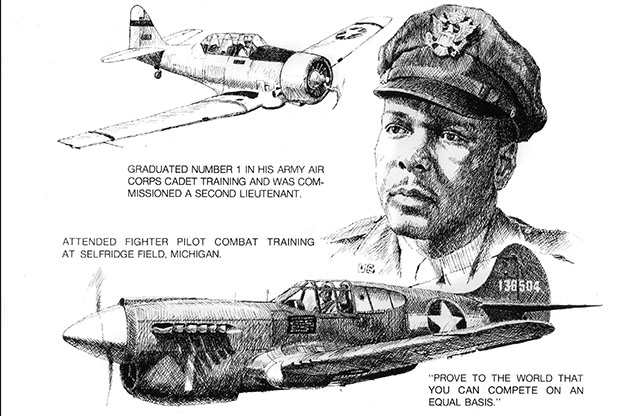
Illustration: CAP/NEA
After World War II, James experienced a pause in his career. The force was drawing down and opportunities were limited for young lieutenants who wanted to fly. He also faced the obstacle of segregation. Blocked from whites-only officers’ clubs, some Tuskegee Airmen had resisted with protests during wartime training.
(It has been widely reported that at least one biographer of James said he was the leader of one of the most well-known of these protests, the “Freeman Field Mutiny” of April 1945, and that he was arrested for refusing to sign a document acknowledging segregated clubs at Freeman Field, Ind. In 2016, Air Force Historical Research Agency historian Daniel L. Haulman investigated and found no US military documentation supporting this claim. James was a courier pilot at the time.)
On July 26, 1948, President Harry S. Truman signed Executive Order 9981, officially integrating US armed forces. But signing a paper was one thing; actually producing integrated units in the force was another. Not many whites would talk to James when he came in the door of his first overseas assignment, at Clark Air Base in the Philippines in September 1949. That is what he later told his son, Daniel James III, in any case.
There was one exception: a friendly Texan named “Spud” Taylor who introduced himself to the new arrival. It turned out the two men had a common interest in music. James played drums and Taylor saxophone.
Eventually they recruited a piano player and formed a trio that would play at special events at Clark.
“Spud,” whose real first name was Claude, was a character, James’ son remembers. He wore cowboy boots with his flying suit and had a handlebar mustache. Spud and Chappie became fast friends. Sadly, Spud was killed in Korea. In his honor, Chappie James named his next son Claude.James himself left for Korea in July 1950. He experienced his first real dogfight while flying ground support in a P-51 Mustang, a prop aircraft, and was jumped by jet-powered MiGs. James later said he maneuvered around until US jets arrived for backup and that he thought he’d hit and damaged one MiG as it was leaving.
“I never had time to think about getting killed. There was too much to do,” he told an interviewer in 1977.
Eventually James flew 101 Korea combat missions in P-51s and F-80s. He transferred back to the US in July 1951, where he trained as an all-weather jet pilot with the 58th Fighter-Interceptor Squadron at Otis AFB, Mass. At this point, his career began to take off.
Gregarious, prepared, and organized, James was a natural leader. Once he returned from Korea his progression up the ranks of the service was rapid. By early 1953 he was a squadron commander. Then it was Air Command and Staff College, a staff officer stint at USAF headquarters in Washington in the office of the Deputy Chief of Staff for Operations, and European service at RAF Bentwaters, England. In the early ’60s he was deputy commander for operations at Davis-Monthan Air Force Base in Arizona with the 4453rd Combat Crew Training Wing.
Then he got the call to go fight in Vietnam.
James flew 78 more combat missions in Southeast Asia, many of them through heavy flak. As deputy commander for operations and later vice wing commander of the 8th Tactical Fighter Wing, he was reunited with ace pilot and wing commander Robin Olds, who James had met during his Pentagon years. The two men formed a strong leadership and combat team, inevitably dubbed “Black Man and Robin.”
Operation Bolo was perhaps the high point of their professional relationship. Dreamed up by Olds, it was an aerial trap for enemy MiGs, which had been evading US fighter escorts and attacking heavily laden F-105 fighter-bombers en route to targets.
The January 1967 operation began with a force of F-4 fighters impersonating an F-105 flight. The F-4s used F-105 refueling altitudes, approach routes, airspeeds, radio call signs, and other distinctive indicators. For the first time, the F-4s were also equipped with ECM pods to deceive the enemy’s missile and flak acquisition and tracking radars, according to Aces and Aerial Victories, an official history of USAF in Southeast Asia.
Each flight of this deception force consisted of four F-4Cs. Olds led the first flight, appearing right on time on target over Phuc Yen, northwest of Hanoi, at 3:00 p.m. local time.
No MiGs.
Unbeknownst to Olds, enemy ground control had delayed MiG takeoffs by 15 minutes due to overcast skies.
Then James led Ford Flight, the second group of F-4s. It popped out of the clouds right on time, five minutes after Olds. At that moment the MiGs appeared. What followed was a melee that might have been the greatest fighter battle of the Vietnam War.
Three MiGs immediately pounced on James’ flight. Two came from 10 o’clock high, one from 6 o’clock low. Rolling from a left bank to a steep right break, James was suddenly flying right next to his adversary, in what he later termed a strange encounter.
“For a split second, [he] was canopy-to-canopy with me. I could clearly see the pilot and the bright red star markings,” James said in an after-action report.James barrel-rolled to gain separation for attack and fired one Sidewinder. It missed as the MiG broke hard left. But the North Vietnamese pilot had evaded James only to put himself in the flight path of Ford Flight’s No. 2 aircraft, flown by Capt. Everett T. Raspberry Jr. A few more maneuvers, and Raspberry put a Sidewinder up the MiG’s tailpipe.
When it was over, 12 F-4s had engaged 14 MiGs and scored seven confirmed victories, against no losses.
“The MiGs reacted as we had hoped,” said Olds at a news conference in Saigon a short time later. “To make a wonderfully long story short, they lost.”James returned to the US in December 1967 as a vice wing commander at Eglin Air Force Base in Florida. The position was not a promotion, but part of the job entailed speeches in the community and Washington, D.C. Officials began to notice James’ public relations skills. A forceful and convincing speaker, he was defending the Vietnam War at a time the Pentagon and the White House were coming under increasing criticism for the burden the fighting placed on the poor and minorities. Eventually James won over one powerful mentor in particular: Melvin Laird, President Nixon’s Secretary of Defense.
Under Laird, James became a wing commander and the base commander at Wheelus. In Libya, he skillfully managed the difficult drawdown, flying assets out at night to clean out the base in time to turn it over.
In March 1970, Laird called and offered him a job as deputy assistant secretary of public affairs. James demurred, saying he was a fighter pilot, not a public affairs specialist. Laird commented that Chappie had been a fighter pilot, implicitly pointing out that the flying part of James’ career was over. He took the job and eventually served as Laird’s principal public affairs official.
James was promoted to one-star status when he accepted the public affairs job. “He was something,” Laird said in an interview after leaving office.
James’ forte as a spokesman was public speaking, not dealing with the press.
He mixed humor with anecdotes and patriotism into a potent mix that appealed to many types of audiences.
“He was an excellent speaker, a very powerful motivator, and he’s a very imposing figure,” remembered his son Lt. Gen. Daniel James III in his Air National Guard oral history.
By Sept. 1, 1974, James was promoted to lieutenant general when he assumed duty as vice commander of Military Airlift Command, based at Scott AFB, Ill.
On Sept. 1, 1975, he was promoted again, to four-star grade, as commander of North American Aerospace Defense Command (NORAD), with operational command of all US and Canadian strategic aerospace defense forces. He was the first African-American to wear four stars in any branch of the US military.
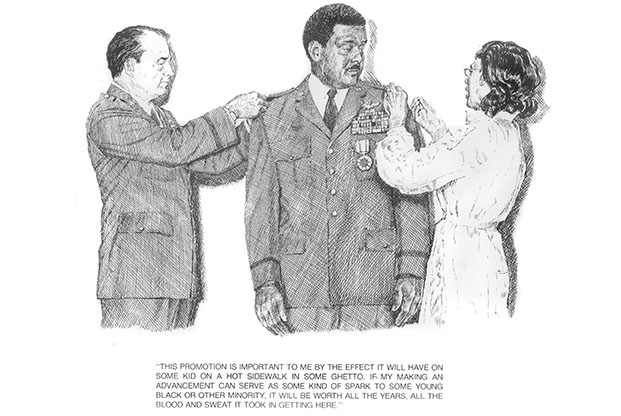
Illustration: CAP/NEA
“If my making an advancement can serve as some kind of spark to some young black or other minority, it will be worth all the years, all the blood and sweat it took in getting here,” James said upon earning his fourth star.
James knew that some blacks felt he had reached his rank by playing along with the powers of the white establishment. He rejected that assessment and felt that it did not give him enough credit for living through the beginning and end of a tumultuous era.
As a youth he’d been ordered by a Navy officer in Pensacola to move to the back of a bus—and had been ashamed of himself after complying. He later said that afterward he vowed to never let anyone or anything stand in his way again. He’d served in the segregated Army Air Corps and taken advantage of one of the first opportunities offered to minorities, the training program at Tuskegee. He’d suffered in silence in the first years of a truly integrated force, while looking for ways to continue to excel and climb.
“I think you are limiting yourself anytime you decide to be a black leader, anytime you decide to be a white leader, anytime you decide to be a Catholic leader,” he said in an interview with television journalist Tony Brown.
“The mantle of leadership comes through preparation,” he said on Brown’s syndicated television program. “Leaders are made, they are not born. And they make themselves through total dedication and preparation.”
James left the NORAD position in late 1977, after a little more than two years in the post. Some news reports at the time speculated that the move was linked to a stiff letter he had sent the Air Force Chief of Staff dealing with a reorganization plan for Aerospace Defense Command.
He then served just two months at the Pentagon before officially retiring on Feb. 1, 1978. Both James and the Air Force said his retirement was for health reasons, and he was already suffering from heart trouble.
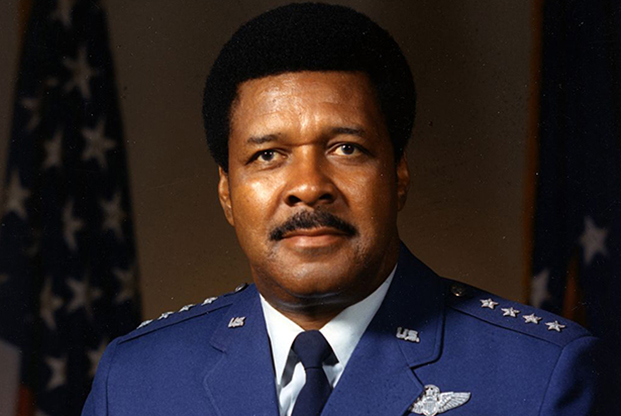
Gen. Daniel “Chappie” James as a four-star. Photo: USAF
James died of a heart attack on Feb. 25, 1978, less than a month after retiring from the service he loved.
In May 1987, then-President Ronald Reagan traveled to Tuskegee Institute and spoke at the dedication of the Gen. Daniel “Chappie” James Jr. Center for Aerospace Science and Health Education.
When he was commander of NORAD, all of America had depended on James’ judgment and courage for survival in the face of nuclear threat, Reagan noted.“He had four stars on his shoulder and 50 stars in his heart,” Reagan said.
Peter Grier, a Washington, D.C., editor for The Christian Science Monitor, is a longtime contributor to Air Force Magazine. His most recent article, “Rare-Earth Uncertainty,” appeared in the August 2018 issue.